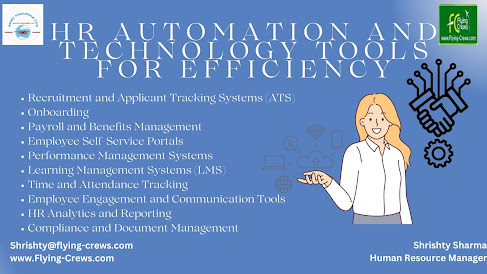HR Automation and Technology Tools for Efficiency
HR Automation and Technology Tools for Efficiency
In the ever-evolving landscape of modern business, Human Resources (HR) departments play a crucial role in shaping organizational success. The traditional perception of HR as a primarily administrative function has undergone a dramatic shift in recent years, thanks to the integration of automation and technology tools. These advancements have not only streamline HR processes but have also redefined the way businesses approach workforce management, employee engagement, and overall efficiency. In this comprehensive article, we delve deep into the world of HR automation and explore the array of technology tools that are driving efficiency in HR operations.
The Evolution of HR Automation:
Historically, HR departments were often bogged down by manual and repetitive tasks, leaving little time for strategic initiatives. The advent of HR automation marked a turning point in the industry. From mundane paperwork to sophisticated data-driven decision-making, HR professionals have transformed into strategic partners within organizations. This evolution is a testament to the power of technology in reshaping workplaces for the better.
Benefits of HR Automation:
Time and Resource Optimization:
Automation liberates HR professionals from time-consuming administrative tasks. Mundane processes like data entry, leave management, and benefits administration can now be executed swiftly, freeing up valuable time for strategic planning and development.
Precision and Accuracy:
Manual errors can have serious repercussions, especially in areas such as payroll and compliance. Automation minimizes the risk of human errors, ensuring that data remains accurate and consistent.
Regulatory Compliance:
Navigating the intricate web of employment regulations can be a daunting task. Automation tools can be programmed to adhere to legal requirements consistently, mitigating compliance risks.
Efficient Recruitment Processes:
The traditional hiring process can be resource-intensive. Automation, in the form of Applicant Tracking Systems (ATS), simplifies candidate sourcing, resume screening, and interview scheduling, expediting the recruitment life cycle.
Empowered Employee Self-Service:
Modern employees expect autonomy and convenience. Technology tools enable self-service portals where employees can update their information, request time off, and access important documents, fostering engagement and reducing administrative overhead.
Data-Driven Decision-Making:
Automation generates a wealth of real-time data that offers insights into workforce trends, performance metrics, and employee engagement. These insights enable HR professionals to make informed decisions aligned with organizational goals.
Technology Tools Transforming HR:
Applicant Tracking Systems (ATS):
ATS platforms have revolutionized recruitment by automating job postings, resume parsing, and candidate communication. These tools streamline the sourcing and screening of candidates, ensuring a more efficient and effective hiring process.
Human Resource Information Systems (HRIS):
HRIS platforms serve as centralized databases for employee information. From payroll and benefits to performance evaluations, these systems provide a comprehensive view of an organization's workforce.
Onboarding Platforms:
Traditional onboarding processes can be overwhelming for both HR teams and new hires. Automation simplifies the process by digitizing paperwork, delivering training modules, and ensuring compliance.
Performance Management Software:
Automation has reimagined performance management. Goal-setting, performance reviews, and feedback mechanisms are now seamlessly integrated, fostering continuous improvement and professional growth.
Employee Engagement Platforms:
Employee engagement is a critical driver of productivity and retention. Technology tools facilitate employee surveys, sentiment analysis, and feedback mechanisms, allowing HR teams to measure engagement levels and implement targeted strategies.
Learning Management Systems (LMS):
Lifelong learning is a cornerstone of modern workplaces. LMS platforms offer a range of online courses, webinars, and skill assessments, empowering employees to develop new skills and enhance their capabilities.
Payroll Automation:
Payroll processing is a complex task that demands accuracy and timeliness. Automation tools calculate salaries, taxes, and deductions accurately, ensuring compliance with legal and regulatory standards.
Attendance and Leave Management:
Automation simplifies time and attendance tracking, enabling employees to submit leave requests and managers to approve them efficiently. This reduces manual errors and enhances transparency.
Analytics and Reporting:
Automation generates comprehensive reports that offer insights into HR metrics. From turnover rates to recruitment success, these analytics inform data-driven decision-making and strategic planning.
Challenges and Considerations:
While the benefits of HR automation are substantial, organizations must navigate challenges such as data security, integration with existing systems, and the balance between automation and the human touch. Moreover, successful implementation requires careful planning, thorough training, and change management strategies to ensure seamless adoption across the organization.
Ethical and Human-Centric Automation:
Amidst the drive for automation, it's crucial to remember that HR deals with people, not just processes. The ethical use of automation and technology should prioritize employee well-being and preserve the personal connections that define HR interactions.
Shrishty Sharma
Manager HR / Author
Asiatic International Corp
Mastering Human Resources in the Modern Workplace
Shrishty@FlyingCrews.com
Shrishty@air-aviator.com
LinkedIn :
Link tree:
https://linktr.ee/Shrishty_HRM_Flying_Crews
Vcard:
https://shrishtysharma.vcardinfo.com
Instagram :
https://www.instagram.com/flyingcrewhrm
YouTube :
https://www.youtube.com/aerosoftcorp
Books by AlfaBooks
Flying High: A Guide to a Career in Aviation Industry
Books
"Flying High: A Guide to a Career in the Aviation Industry"
Pilot's Career Guide
Order here
"Pilot's Career Guide" is a book written by Captain Shekhar
Most Successful Female Entrepreneurs of India
Books by Grishma Vijay , Capt. Shekhar Gupta
The Most Successful Female Entrepreneurs in India is a collection of life lessons from successful women from all areas of life in India.
All Best Career Guide
Books by Capt Shekhar Gupta
A Great Resource for Students, Parents, and Schools.
Buy On Amazon :
Buy On Amazon Kindle:
https://www.amazon.com/dp/B07PVK3DTN
Buy On Kobo:
https://www.kobo.com/in/en/ebook/pilot-s-career-guide
Buy On Google Play:
Buy On Apple Books:
https://books.apple.com/us/book/pilots-career-guide/id1457304196
ORDER NOW!!!
https://www.portrait-business-woman.com/2024/07/ready-to-share-your-success-story-we.html
www.Portrait-Business-Woman.com
https://www.anxietyattak.com/2024/07/human-resources-management-in-start-ups.html
https://www.anxietyattak.com/2024/07/understanding-role-of-human-resources.html
https://www.anxietyattak.com/2024/07/understanding-role-of-human-resources_15.html
https://www.anxietyattak.com/2024/07/recruitment-and-talent-acquisition-in.html
https://www.anxietyattak.com/2024/07/identifying-key-hiring-needs-and-roles.html
https://www.anxietyattak.com/2024/07/attracting-top-talent-on-limited-budget.html
https://www.anxietyattak.com/2024/07/leveraging-social-media-and-online.html
https://www.anxietyattak.com/2024/07/employee-onboarding-and-integration.html
https://www.anxietyattak.com/2024/07/cultivating-positive-first-impression.html
https://www.anxietyattak.com/2024/07/integrating-new-employees-into-company.html
https://www.anxietyattak.com/2024/07/performance-management-and-feedback.html
https://www.anxietyattak.com/2024/07/setting-clear-performance-expectations.html
https://www.anxietyattak.com/2024/08/building-positive-work-culture.html
https://www.anxietyattak.com/2024/08/encouraging-collaboration-and-teamwork.html
https://www.anxietyattak.com/2024/08/promoting-work-life-balance-in-start-up.html
https://www.anxietyattak.com/2024/08/developing-diverse-and-inclusive.html
https://www.anxietyattak.com/2024/08/employee-motivation-and-retention.html
https://www.anxietyattak.com/2024/08/understanding-employee-motivation.html
https://www.anxietyattak.com/2024/08/conflict-resolution-and-employee.html
https://www.anxietyattak.com/2024/08/effective-communication-in-employee.html
https://www.anxietyattak.com/2024/08/understanding-employee-rights-and.html
https://www.anxietyattak.com/2024/08/remote-work-and-hybrid-workforce.html
https://www.anxietyattak.com/2024/08/managing-remote-teams-effectively.html
https://www.anxietyattak.com/2024/08/scaling-hr-operations-for-growth.html
https://www.anxietyattak.com/2024/08/scaling-hr-operations-for-growth.html




